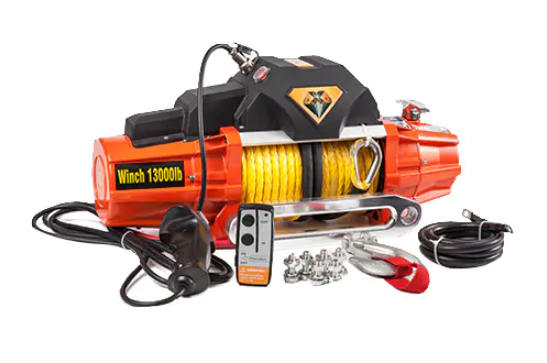Step-by-step Guide On How To Use A Portable Electric Winch Before utilizing a winch, prioritizing safety by adhering t...
Before utilizing a portable electric winch, ensure it is firmly affixed to a stable surface. Connect the winch to a powe...
Off-roading in a 4x4 vehicle can be an exhilarating adventure, but it also comes with its share of challenges and obstac...
Off-roading in a 4x4 vehicle can be an exhilarating adventure, but it also comes with its share of challenges and obstacles. When you find your 4x4 stuck in mud, sand, or rough terrain, a winch becomes your best friend. In this comprehensive guide, we will explore the world of 4x4 winching, covering everything from winch selection to best practices for safe and effective recovery.
Before delving into winch selection and usage, let's understand why having a winch on your 4x4 is crucial.
4x4 vehicles are designed for rugged terrains, but they can get stuck or stranded. A winch empowers you to recover your vehicle without relying on external assistance, providing a sense of self-reliance and independence during your off-roading adventures.
A winch enhances your safety while off-roading. It allows you to navigate challenging situations with confidence, knowing that you have a tool to pull you out of trouble if necessary.
A winch isn't just for self-recovery. It enables you to assist fellow off-roaders in distress, reinforcing the sense of camaraderie in the 4x4 community.

Choosing the right winch for your 4x4 is a critical decision. Consider the following factors when making your selection.
The winch's capacity is measured in pounds and refers to the maximum weight it can pull. To determine the appropriate capacity for your 4x4, you should consider the vehicle's weight and any additional load it might be carrying. A winch with a capacity of at least 1.5 times your vehicle's weight is recommended to accommodate unexpected challenges.
Electric winches are the most common choice for 4x4 vehicles due to their ease of installation and operation. Hydraulic winches are typically heavier and more complex, often used in industrial applications.
Both steel cables and synthetic ropes have their advantages. Steel cables are durable but heavy, while synthetic ropes are lightweight and safer in case of breakage. Consider your usage and preferences when selecting the rope type.
Line speed is the rate at which the winch pulls in the cable or rope. A faster line speed can be advantageous in certain situations, but it often comes at the expense of pulling power. Select a winch with a line speed that suits your needs.
Ensure that the winch you choose is compatible with your 4x4's make and model. Some vehicles may require additional mounting kits for proper installation.
Opt for a reputable winch manufacturer. Brands with a strong track record tend to provide reliable products and better customer support.
While it's important to invest in a quality winch, your budget is also a consideration. Balancing your needs with your financial constraints is essential.
Once you have selected the right winch for your 4x4, it's essential to understand safe winching practices to ensure a successful recovery and prevent accidents.
1. Inspect Your Equipment: Before every off-road trip, inspect your winch, rope, or cable, and all associated gear for any signs of wear or damage.
2. Use Proper Anchoring: Ensure you have a secure and stable anchor point for winching. This can be a tree, rock, or another vehicle. It should be capable of withstanding the pulling force.
3. Maintain Tension: Keep tension on the rope or cable at all times while winching to prevent slack and potential whipping.
4. Operate Safely: Stand clear of the winch and rope while in operation, and use the winch's remote control from a safe distance.
5. Communicate Clearly: Establish clear hand signals or communication with a spotter or fellow off-roaders to coordinate winching operations.
6. Watch Your Speed: Winch slowly and steadily. Avoid jerky or sudden movements that could cause the cable or rope to snap.
7. Carry Essential Gear: Always have safety gear on hand, including gloves, a recovery strap, and shackles, to ensure safe winching.
A winch is a valuable addition to your 4x4, providing self-reliance, safety, and the ability to assist others in challenging situations. When selecting a winch, consider capacity, type, rope material, line speed, compatibility, brand reputation, and your budget.
Remember to prioritize safety at all times when winching. Inspect your equipment regularly, use proper anchoring, maintain tension, and communicate effectively during winching operations. With the right winch and safe practices, your 4x4 adventures will be both thrilling and secure.
For more tips and insights on off-roading and 4x4 adventures, visit [https://www.hcwinches.com/contact/]

As a famous wholesale high power electric winches Manufacturers, We have a strong desire that we can double-win with our customer.
Add:Changtan Industrial Zone, Zhang shui Town, Haishu District, Ningbo, China
Tel:+86-18367483862
WeChat:+86-18367483862
WhatsApp:+86-151 6815 7361
E-mail:sales@hcwinches.com
E-mail:sales2@hcwinches.com
TOP
